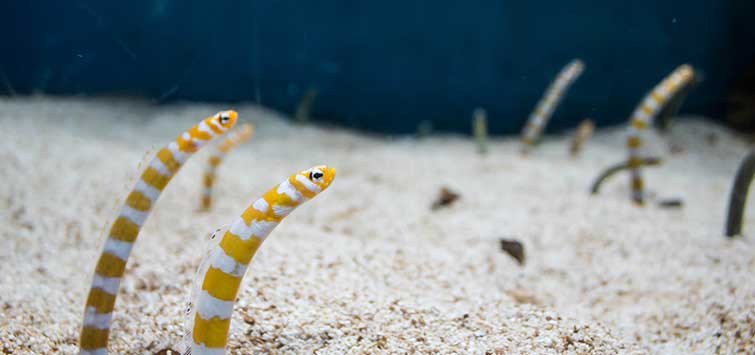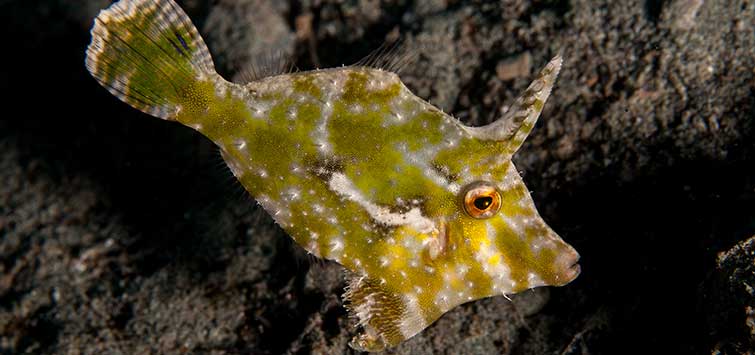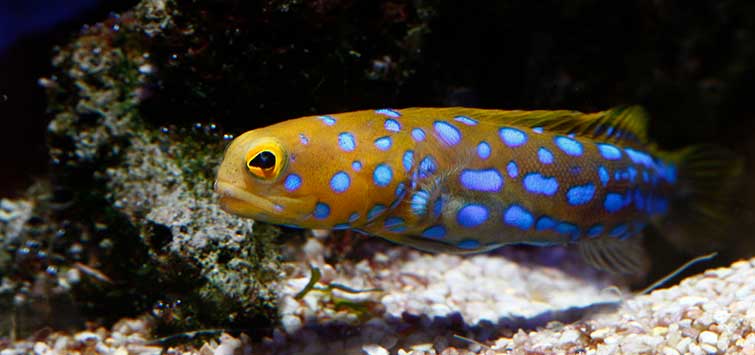Oddballs for the Marine Aquarium
Author: Richard Aspinall
Are you looking for something different to put in your saltwater aquarium? A long-time marine aquarist has a list of some unique species that range from easy to keep and reef appropriate to some of the most challenging fish available.
Thinking Outside the Tank
Many marine aquarists, me included, spend an incredible amount of time and money on our life-consuming passion with the aim of creating one singularly impressive reef tank. Striving toward the culmination of our art produces tanks that are replete with colorful and collectible corals, alive with shoaling anthias, and completed with showcase tangs and angels swimming serenely from bommie to bommie without a care in the world.
The thing is, once we have achieved the system of our dreams, we realize that there is a whole world of fascinating fishes that we passed by in our rush to create a tank with the wow factor. There’s nothing wrong with this, of course. It’s just that after we have achieved our ambitions, our thoughts turn to other less obvious challenges and we enter into negotiations with our significant others about yet another big, and no doubt expensive, salty box. “Just one more tank Hon, honestly...it’ll help the kids with their schoolwork,” and other almost believable entreaties.
The soon-to-be-built new tank that fills our thoughts might be a biotope system, such as a shallow-water mangrove environment, a sea-grass system complete with Catalaphyllia,or a nano system for seahorses. The potential systems are as numerous as the hobbyists who design them (in their minds and in reality), but in many instances, it’s the challenge of keeping something a little strange, or something a little different, that drives us. Perhaps we want something a little odd!
Defining Oddballs
So what makes an oddball? Well, that’s a very personal matter, so this article is just my take on the subject. But there are, for me, several factors that qualify a fish as an oddball. First come shape and body pattern. Fishes with unusual body shapes have very often evolved and adapted to fit unique and fascinating ecological niches. An aquarist is presented with a challenge here in recreating the fishes’ habitat as well as providing the basics. There’s also, quite simply, the fact that they just look plain odd!
Secondly, I consider a fish odd if it has interesting behavior that makes it different from run-of-the-mill fish. Interesting behavior is, of course, linked to natural habitat, food supply, and the fishes’ biology in general, but some fish seem to take this further and show what might be considered personality—an oddity within the fish world, which makes them very endearing and worthy of the extra expense and difficulty that may be required to keep them healthy.
Lastly, there are fish that, due to a quirk of their biology, require very special care (frequently species tanks) in order to survive or have such interesting biology that their behavior is different again from other, more mainstream fish. I’m thinking hear of syngnathids such as seahorses and pipefish as an example—species with very specific requirements and in which the male gives birth.
My Favorite Oddballs
To a lesser or greater extent, all the species and groups we shall meet exist within more than one, if not all, of these categories. A word of caution, though: Several of the species and genera listed below require significant skill and commitment to keep with any degree of success, so please make sure you can meet the care and habitat requirements of a fish before you purchase it. A good dealer will usually allow you to place a deposit on a fish while you do more research about it. This also allows you to check over the course of a few days or (even better) a few weeks that the fish is healthy and eating. So let’s meet the oddballs.
Fang Blennies
Fang blennies are mainly very undesirable fish that rely on stealth and deception to steal scales and mucus from other fishes. I’ve included them here due to the Aspidontus genus, particularly A. taeniatus, which achieves this lifestyle by mimicking a more useful and welcome fish, the blue streak cleaner wrasse (Labroides dimidiatus), in order to launch surprise attacks on unsuspecting fish. Unsurprisingly, real cleaner wrasses are very active in driving fang blennies away from their territory.
Fang blennies can be kept without other fish and will adapt to eating mysid and brine shrimp, which is welcome, as some species, such as the blue-striped fang blenny (Plagiotremus rhinorhynchos), are very attractive fish indeed. They are also somewhat territorial, so you may be able to keep only one per tank. And, given their predilection for biting other fish, you might have a single fish—an odd choice perhaps, but you’d be unlikely to see many species tanks for single resident fang blennies.
Care level: Easy
Reef safe: Yes
Jawfish
Jawfishes are packed with personality, and I include them here for that reason. They do have a certain look about them that will put some aquarists off, though—you either love that toad-like face or you don’t.
Unlike some of the species in this article, many jawfish are easily kept and make wonderful additions to the average tank. But they do have a few specific care requirements, the main one being a deep bed of mixed substrate for them to dig their burrows.
Being poor swimmers and an easy target for predators, jawfishes rely on digging burrows and sitting within them, waiting to nip out and pick morsels of food from the water column. Watching the male resting proudly at the entrance to his burrow, incubating his brood within his mouth, is a real talking point if you are able to acquire a pair.
The digging habits of jawfish may cause substrate to cover or disturb nearby corals and cause rockwork collapses, so plan ahead and secure your rockwork during you tank setup if you are thinking of acquiring a jawfish. This is good advice for saltwater tanks, anyway.
There are several species of note, which if introduced together can be kept in species-specific groups in larger tanks. The blue-spotted jawfish (Opistognathus rosenblatti) is a stunning fish with neon spots that must be kept in a cool-water setup to do well. The yellow-headed jawfish(O. aurifrons) is also a beauty and will do well in a typical tropical tank. Both reach around 4 inches in length and do well in a tank of around 30 gallons or more.
Care level: Easy to intermediate
Reef safe: Won’t eat corals, but may disturb them by digging
Frogfish
If ever a group of fish were needed to epitomize the word “odd,” the frogfishes would be ideal. Their astounding skin coloration and texture alone makes them unique in the fish world and certainly places them in a class of their own.
Frogfish are from the anglerfish group, named after the modified spine they use to lure prey fish toward their cavernous mouths. A small fish mesmerized by the worm-like or fish-like lure is no match for the rapid inrush of water into the frogfish’s mouth, which can open with remarkable speed.
This hunting strategy allows for a very sedentary lifestyle, which will see a single frogfish occupy a very small area for weeks, if not months, at a time. They rely on fish coming to them, so they are very poor swimmers. To move about, they mostly rely on their modified pectoral fins, which resemble legs and allow the fish to walk across the rockwork and amid corals and sponges.
Frogfish do well in small aquaria, though they do produce a significant amount of waste (they can eat fish up to half their size), so you will need to keep on top of water changes and ensure good filtration. As for feeding, guppies or other cheap livebearers were the foodstuff of choice in the past, but nowadays frozen whole fish are recommended. They can be fed to frogfish with a feeding stick, which can be shaken to simulate movement to encourage a reluctant fish to eat. Antennarius pictus, A. striatus, and A. hispidus are commonly available.
One note of caution seems common in the literature—these fish are easily stressed, and stress in Antennarius species is linked with mysterious deaths when no other cause is apparent.
Care level: Moderate
Reef safe: Yes, but they may walk on corals and present a risk to ornamental shrimps and any fish they can eat
Drums
Drums belong to a large family, with over 250 species across 70 genera or so, and occasionally make their way into the trade, mainly as juveniles. Their name comes from their ability to use their swim bladders and associated muscles to produce croaks and similar noises.
Drums can, depending on the species, achieve relatively large sizes, with the spotted drum(Equetus punctatus), which is occasionally offered for sale, reaching 10 inches or so. Given their size, they need large aquariums with large areas of substrate to satisfy their foraging methods. They feed largely on buried fare in the wild, such as polychaete worms. Getting them to recognize standard aquarium fare as a food source has been reported as challenging.
They are largely nocturnal feeders, so low-level lighting is a must, and anyone intending to purchase an attractive young specimen must bear in mind that they will grow and lose some of their juvenile cuteness.
They are reputedly skittish and will need to be kept with other, less boisterous species if not kept as the sole residents of a tank.
Care level: Moderate
Reef safe: Yes, but they will require low lighting that will be insufficient for most coral growth
Garden Eels
Garden eels are fascinating fish that require a very specific habitat, which means that a large species tank is best. They live in large colonies (or gardens), consisting of dozens of individuals, in shallow areas with good currents. Each individual resides in a deep, narrow burrow in fine sand. Garden eels are very poor swimmers and withdraw into their burrows when threatened. Watching a colony in the wild, swaying in the current and responding to predators swimming past, is a great sight.
Due to their nature, only aquarists with the ability to provide the correct conditions for garden eels ought to consider keeping them. The sand bed needs to be at least 12 inches deep (for fully grown fish) and perhaps even deeper (although young fish can tolerate 5 to 6 inches). The fish require good currents and frequent feedings to keep them healthy, which is probably not a problem, but keeping them with other fish that will outcompete them for food is probably a bad idea. If you can meet these requirements, then acquiring a small group, perhaps six or so, would make a fascinating display.
In a very large tank, there is nothing to stop you from keeping a colony of garden eels with other fish and corals as long as the eels’ requirements are met and, as stated, they get an adequate supply of food in the current.
Care level: Moderate
Reef safe: Yes
Flatfishes
I include flatfishes, a large group, due to my regard for one particular species: the banded sole (Soleichthys heterorhinos). I first came across it in the wild several years ago, when I was entirely fooled by its camouflage. Looking remarkably like distasteful flatworms, banded soles travel unmolested across the reef at night and take to gliding in the substrate with only their eyes showing through the day.
Their burrowing habits mean they will need an area of open, fine sand, and may well require live food introduced to their vicinity to encourage them to feed.
There are five members of the genus Soleichthys, and they and many other soles rely on some level of mimicry.
Are they odd? Well, yes, and they are also wonderful examples of evolution. Should you find one, it would make a fascinating talking point, and their often rapid and undulating motion is quite captivating.
Care level: Intermediate
Reef safe: Yes, but they may take ornamental shrimps and prey upon tubeworms and echinoderms
Pipefish
Pipefish, and of course their cousins the seahorses, are the subjects of articles and books in their own right, so I can only scratch the surface in this short article.
Right off the bat, I should mention that these are not beginners’ fish. The first issue they present to an aquarist is their feeding requirements. Many will not accept anything but live food, such as adult brine shrimp, small ghost shrimp, and mysid shrimp. They also must be fed often, at least two to three times a day. More often is even better. If you have the time and the inclination to offer a regular supply of such fare, then you might have success.
Small or nano systems are great for pipefish, which will ensure they get enough to eat. They can be kept with other timid fish, such as yellow clown gobies (Gobiodon okinawae), that won’t grab the food before the pipefish. Several species are very shy, so provide open rockwork, and be aware that some species, such as the stunning blue-stripe pipefish (Doryrhamphus excisus), reach only a little under 3 inches. If you wish to keep larger fish, try the banded pipefish (D. dactyliophorus) or the orange-banded pipefish(D. pessuliferus).
I would say pipefish are oddballs, not only for their snake-like form, but their charming behavior. Some are monogamous for life and will, every morning, reinforce their bond with a slow dance replete with sinuous body contact. Like seahorses, the male will receive the egg mass from the female and carry the eggs until hatching in a specially developed pouch or on a specific area of skin, depending on the species.
Care level: Intermediate to expert
Reef safe: Yes, and they may benefit from live rock replete with small crustaceans
Shrimpfish
Shrimpfish are truly wonderful fish that, when kept in groups amid branching corals, sea grass, or even among the roots of mangroves, make a fascinating display as they swim as a single school. These fish are odd, for me at least, due to their habit of living life head down. If not for this habit, they would perhaps be rather boring fish.
Feeding is again the challenge here, and shrimpfish have similar requirements to pipefish and seahorses in that they require regularly available small crustacean prey, such as amphipods and small shrimp. Due to their social nature, they are not aggressive to each other or to other fish species, so keeping a small group in a reef aquarium is possible. But their remarkable appearance often means they are used to great effect in biotope or more habitat-specific aquaria. I have held a long-standing urge to keep them in a sea-grass-biotope aquarium, but that may have to wait.
There are five species within the group, with Centriscus scutatus, C. cristatus, Aeoliscus strigatus, and A. punctulatus being available, though the coral shrimpfish (A. strigatus) seems quite common in the trade in my experience.
Care level: Intermediate to expert
Reef safe: Yes
Filefish
Sadly, one of the most commonly seen and admired filefish is the orange-spotted filefish (Oxymonacanthus longirostris), which is often doomed to an early death when aquarists realize its need for live coral polyps is too much of a challenge or ytoo pricey to accept. Stories exist of fish that have been trained to accept other fare, but they represent a small fraction of the total number that have starved over the years. The work done by Matt Pederson and other experts in creating protocols for weaning the fish away from polyps and onto other foodstuffs is a welcome step in the right direction, however.
There are other species of filefish that are more easily kept due to their more generalized dietary needs, but I would describe O. longirostris as an expert-level fish that should be avoided by the vast majority of hobbyists.
Filefishes’ love of polyps has meant that aquarists have used them to consume Aiptasia anemones. Acreichthys tomentosus,in particular, is reputed to relish these pest anemones and will take other meaty foods.
Species such as the tasseled filefish (Chaetodermis penicilligerus), the colored filefish (Pervagor melanocephalus), and the orange-tailed filefish (P. spilosoma) are reputed to be easy to keep in a mixed aquarium, but none can be assumed to be entirely reef safe and may well be best in a FOWLR system.
Care Level: Intermediate to expert
Reef Safe: No
Boxfishes
There are two groups of fishes here that commonly make it into the hobby: the cowfishes, so named for their horns, and the boxfishes, named for their chunky frame, which if cut through the middle would be almost square. The ostraciids vary in suitability for the average hobbyist. While they are mainly peaceful and can be kept with other fish, they are, in some instances, liable to grow to an excessive size, and many can release a powerful toxin when stressed or threatened.
The yellow boxfish (Ostracion cubicus), for example, will reach over 15 inches in length and change from an adorable polka-dotted yellow cube into a sizable fish that can release the aforementioned toxin.Avoid keeping ostraciids with aggressive fish! Toxin release has been cited as the cause of death for fish in the same tank, so this should be seen as a real possibility.
Several species, such as the striped boxfish (O. solorensis) and the spotted boxfish (O. meleagris), rarely exceed 6 inches and make better candidates for an average-sized tank than their larger cousins.
Care level: Experienced fish keepers only
Reef safe: May nip at large-polyp stony (LPS) corals, clam mantles, tubeworms, and echinoderms
Find the Oddball for You
So that’s my list of oddities for the marine tank. There are some real beauties here and some real challenges, so make sure your skill level matches your purchases. You too could have an oddball.
See the full article on TFH Digital http://www.tfhdigital.com/tfh/201209#pg87

.png?h=595&iar=0&w=2781&hash=5FD5E69473BCC22199FBFA2FB71B6033)



